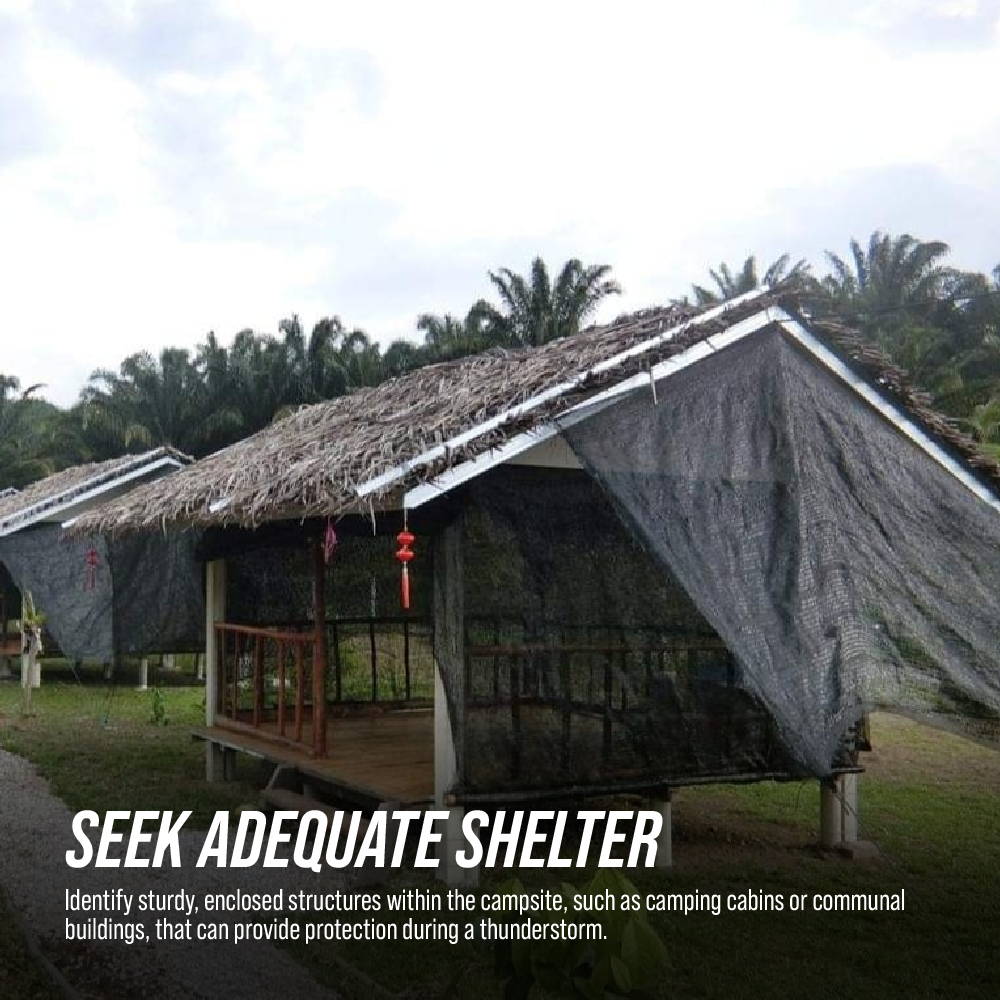Share
Camping Lightning Safety | 5 Must-Know Tips
When exploring the stunning natural landscapes of Malaysia, camping can be an unforgettable experience—but it’s essential to prioritize safety, especially regarding lightning. Thunderstorms are common in tropical climates, so understanding camping lightning safety is crucial for any outdoor enthusiast. In this article, we’ll share practical safety tips and guidelines to help ensure your next adventure is not only memorable but also safe.
1. Stay Updated on Weather Conditions

Always monitor weather conditions before your camping trip. Use reliable weather apps like MyCuaca or AccuWeather to check for thunderstorms or lightning alerts in your camping area. Staying informed is one of the simplest ways to practice camping lightning safety—helping you plan better or postpone the trip if needed.
Tip: Learn basic first aid and CPR before your trip. It could save lives in emergencies when help is far away.
ㅤ ㅤ ㅤ ㅤ ㅤ ㅤ ㅤ ㅤ ㅤ ㅤ ㅤ ㅤ ㅤ ㅤ ㅤ ㅤ ㅤ ㅤ ㅤ ㅤ ㅤ ㅤ ㅤ ㅤ
2. Choose a Safe Campsite and Reliable Tent:

Selecting the right campsite plays a significant role in ensuring camping lightning safety. Avoid open areas, exposed hilltops, and high points that increase the risk of lightning strikes. Instead, opt for locations surrounded by lower vegetation or natural formations that provide some level of protection. Seek out areas near dense tree cover or rocky outcrops that can offer additional safety measures.
Use a high-quality, reliable tent with strong waterproofing and sturdy poles to withstand sudden weather changes. While tents don't protect against lightning, they do offer shelter from wind and rain while you wait out a storm in a safer location nearby.
ㅤ ㅤ ㅤ ㅤ ㅤ ㅤ ㅤ ㅤ ㅤ ㅤ ㅤ ㅤ ㅤ ㅤ ㅤ ㅤ ㅤ ㅤ ㅤ ㅤ ㅤ ㅤ ㅤ ㅤ
3. Equip Yourself with Camping Lightning Safety Gear:

Being prepared is half the battle. Include these items in your packing list:
- Portable weather radio or a weather app
- Fully charged phone + power bank
- Waterproof flashlight + spare batteries
- Comprehensive first aid kit
- Emergency whistle
These tools help you stay informed and ready if weather conditions suddenly change.
ㅤ ㅤ ㅤ ㅤ ㅤ ㅤ ㅤ ㅤ ㅤ ㅤ ㅤ ㅤ ㅤ ㅤ ㅤ ㅤ ㅤ ㅤ ㅤ ㅤ ㅤ ㅤ ㅤ ㅤ
4. Seek Adequate Shelter:

When you hear thunder or spot lightning, move quickly to a safe shelter. The best options are:
- A fully enclosed building or camping cabin
- A hard-topped vehicle (acts like a Faraday cage)
To ensure proper camping lightning safety in Malaysia, avoid open tents, picnic shelters, and standing near tall trees or metal poles, as these can be dangerous during a storm.
ㅤ ㅤ ㅤ ㅤ ㅤ ㅤ ㅤ ㅤ ㅤ ㅤ ㅤ ㅤ ㅤ ㅤ ㅤ ㅤ ㅤ ㅤ ㅤ ㅤ ㅤ ㅤ ㅤ ㅤ
5. Camping Lightning Safety Guidelines From Experts
ㅤ ㅤ ㅤ ㅤ ㅤ ㅤ ㅤ ㅤ ㅤ ㅤ ㅤ ㅤ ㅤ ㅤ ㅤ ㅤ ㅤ ㅤ ㅤ ㅤ ㅤ ㅤ ㅤ ㅤ
Individual
To reduce your risk of being struck by lightning while outdoors, preparation is key. Always check the latest weather updates before heading out, and identify nearby safe shelters in case thunderstorms develop.
Your actions during stormy weather greatly affect your safety. The most effective way to stay safe is to avoid being caught outdoors during a thunderstorm. If there’s a risk of lightning, it’s best to seek shelter immediately—don’t wait for rain or thunder.
Make use of tools like smartphone weather apps, local radar, and portable NOAA Weather Radios to monitor changing conditions—especially during activities like camping or boating. If the weather forecast shifts or storm clouds begin forming around you, take shelter without delay. The moment the sky turns threatening or you hear distant thunder, head to a safe indoor space.
ㅤ ㅤ ㅤ ㅤ ㅤ ㅤ ㅤ ㅤ ㅤ ㅤ ㅤ ㅤ ㅤ ㅤ ㅤ ㅤ ㅤ ㅤ ㅤ ㅤ ㅤ ㅤ ㅤ ㅤ
Small Groups
When heading outdoors in a group, preparation is crucial. Make sure at least one person checks the weather forecast before the trip, and ensure everyone in the group knows the lightning safety plan.
Assign a group member to actively monitor the weather using tools like weather.gov, Doppler radar, or reliable weather apps. Portable NOAA Weather Radios or even a basic AM/FM radio can be helpful as well. If there's a chance of thunderstorms and you still go ahead with your activity, have a clear safety strategy. Once on-site, identify your nearest shelter and factor in how long it’ll take to get there if a storm approaches.
The moment you hear thunder—even if it’s faint—move the entire group to safety immediately. Don’t delay. Lightning can strike even before the rain begins. Stay sheltered and avoid resuming outdoor activities until at least 30 minutes after the final thunderclap.
ㅤ ㅤ ㅤ ㅤ ㅤ ㅤ ㅤ ㅤ ㅤ ㅤ ㅤ ㅤ ㅤ ㅤ ㅤ ㅤ ㅤ ㅤ ㅤ ㅤ ㅤ ㅤ ㅤ ㅤ
Large Groups & Events
When organizing outdoor events for large crowds, advanced planning is a must. Ensure the team in charge of safety checks reliable weather forecasts before the event and shares the lightning safety plan with all event staff.
Designate safety personnel to monitor real-time weather using smartphone apps, local radar, or portable NOAA Weather Radios. For fast-moving storms, visual observation alone may not be enough. Equip the team with portable lightning detectors to track lightning activity at a safe distance, allowing more time to evacuate attendees if needed.
Identify safe shelters before the event and make evacuation routes clear. It’s important to estimate how long it will take to get everyone to safety. Consider including lightning safety info on programs, banners, or signage throughout the event grounds. Visible reminders can help raise awareness and keep everyone alert.
Adapted from the National Oceanic and Atmospheric Administration (NOAA): Lightning Safety. Is not subject to copyright.









![[NEW] KZM Black Cot Tent II](https://cdn.shopify.com/s/files/1/0511/4940/6385/products/K221T3T01_01.jpg?v=1656476093&width=600)






